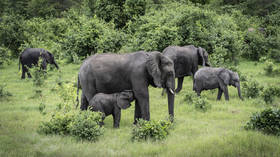Cause of mysterious elephant deaths in Botswana revealed

Around 250 African elephants were killed by neurotoxins produced by microscopic algae that they consumed from large puddles of water, an international group of scientists have established.
Cyril Taolo, the deputy director of Botswana’s Department of Wildlife and National Parks, revealed cyanobacteria to have been the cause of the deaths during a news conference on Monday.
He rejected the possibility that humans were the cause of the deaths, and instead blamed changes to the environment.
“There’s absolutely no reason to believe that there was human involvement in these mortalities ... This is not a phenomenon that was just seen now, it is something that happens quite a lot when there are these environmental changes,” Taolo explained.
A bacteria known as Pasteurella Bisgaard taxon 45, which led to blood poisoning, was also identified in tests on more than 30 elephants that died in similar circumstances in Zimbabwe.
Roy Bengis, a wildlife specialist at the University of Pretoria in South Africa who formerly served as the chief state veterinarian at Kruger National Park, said it was also possible that the elephants had absorbed the neurotoxin through their skin.
The animals tend to drink large amounts of water, but also spend a lot of time in it, rolling in mud and spraying themselves, he explained.
Scientists had looked for traces of cyanide, which is commonly used by poachers to kill elephants, but none was found in the carcasses or near the waterholes. The dead elephants still had their tusks, which ruled out the possibility of poaching.
A total of 350 elephants mysteriously died in Botswana in 2020, and 35 more died in similar circumstances in Zimbabwe. Elephants of both genders and all ages were affected.
As of today, there are approximately 350,000 elephants left in the African Savanna. However, poaching is resulting in elephant populations shrinking by 8% per year on the continent.













